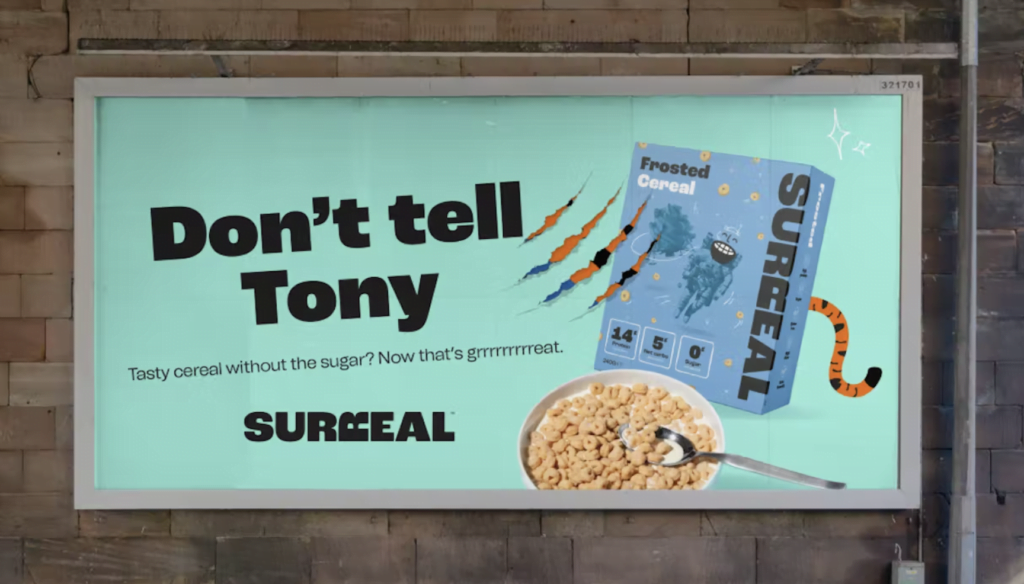We’re calling it, here are five key marketing trends to watch in 2023.
Where did 2022 even go? It was another turbulent year for most, following in the footsteps of the equally-as-strange periods that were 2020 and 2021. It’s not all bad though; the slow but definite rise to mass insanity (dramatic, us?) graced us with next-level creativity that brought some brilliant campaigns worthy of Slacking your colleagues.
2022 really showed out with some fantastic campaigns and content and not-so-fantastic ones (we’re looking at you, Balenciaga). One stand-out brand for us was Surreal, who can frankly do no wrong, and their hilarious Surreal cereal x Wild smashed it out of the park. Another fantastic campaign was the Cristiano Ronaldo and Lionel Messi ad for Louis Vuitton, which went viral, driving a combined 72 million likes on Instagram and making Cristiano Ronaldo the first person to pass 500 million followers. (Sorry Kim K)

Anyway, you know what they say, good things come in threes. So, here’s to 2023 and five marketing and digital trends we believe will create a riot (in a good way…still looking at you Balenciaga).
Whatever the hell Gen Z is doing
It’s no secret that the Gen Z audience heavily uses social media, and the top three platforms in order are TikTok, Instagram and YouTube. A reported 61% of the generation stated that they prefer videos under a minute in length, hence the rise of TikTok and YouTube Shorts.
In an attempt to indulge in a more authentic social media lifestyle, Gen Z has flocked to BeReal. The app launched in 2020 and was the top social networking app on the App Store last year. A notable trend, they’ve also been fawning over reality on Instagram with ‘photo dumps,’ an unfiltered and unorchestrated collection of images to counteract the seemingly adverse effects curating the ‘perfect’ feed has created over the last few years.
Gen Z’ers have started virtual mood boarding again.
Recent research by Pinterest states that in Q3, Gen Z users grew in double digits year on year on the platform. That incredible growth came from Pinterest creating more tailored, personalised experiences for its users, putting video and story-like content at the forefront.
To connect with their younger market, Google’s latest AR campaign, ‘Find that thing,’ was purposely aimed at their Gen Z audience to meet them in their world. Utilising the power of search with a visual spin, using Google Lens.
The key takeaway? Gen Z is driven by visual and more authentic, personalised experiences, so to meet Gen Z where they are, keep it visually impactful and worthy of their (very precious) time with shorter form content.
Still on augmented reality and AI
Last year, our blog post on 2022 trends predicted that augmented reality would continue to grow, and in case you missed it, robots are still taking over.
The incorporation of AR and AI in marketing strategies this year has been everywhere, and there are no signs of slowing down. Despite the recent uproar surrounding AR and AI, the mixed reality market is expected to grow by 220billion USD and counting, and brands everywhere are finding new and innovative ways to take advantage. And if you haven’t created an AI selfie yet, where have you been?
In a post-Covid (?) world, the boundaries between human, digital, physical, and virtual are merging as audiences move to a preference for more immersive experiences.
Consuming AI (literally) has taken a new form in the latest partnership between the skincare brand Neutrogena and Nourished, a company that 3D prints dietary supplements. Using the same AI technology in Neutrogena’s Skin360 skin assessment, the SkinStacks supplements create a personalised and tailored product and experience for everyone with the data gathered from the digital skin assessment.
In a recent surge of consumers taking the ‘health from within’ approach, this partnership launches at the perfect time, as 92% of beauty consumers are purchasing products with the aim of nourishing from the inside out.
Brands can use AI and AR tools strategically to strengthen their consumer relationships. For example, fast-food chain Chipotle is the latest in attempting to target its Gen Z and Millennial audiences with a recently released AI campaign using Snapchat Lens.
Utilising the healthy lifestyle changes that 73% of people who make New Year resolutions create, the restaurant offered 100,000 participants a reward of free guacamole. Chipotle will also encourage users with meditation prompts and exercises to promote healthy habits to kickstart the new year. And, to promote its mobile app, Chipotle is offering its new healthy menu items digitally only, forcing its customers to download the app and engage, which has been the company’s priority for the last few years.
Feeding into the notion of social media being an illusion, social platform giant TikTok has launched its own AR platform named ‘Effect House.’ From cool transitions to interesting voice effects, TikTok is a hub of creativity and innovation, and that experience has gone next level with this new platform. Since the launch of Effect House in its beta form, more than 1.5 billion videos have been created and gathered over 600 billion views worldwide.
Print advertising makes a comeback
As digital marketing channels grew, traditional print advertising and print dramatically declined in previous years. However, consumers are becoming numb to the constant digital noise, and a survey by Adobe stated that 62% of participants found online ads ‘annoying’ while 45% said they were ‘invasive.’
Research states that 82% of consumers trust print ads the most when making a purchase decision, while 92% of 18-23-year-olds say that it’s easier to consume print than digital. Although spending for print advertising is on a decline, expected to hit 27 million in 2023, print marketing brings a value of a 9% customer response rate. In contrast, digital marketing sees a 1% or even less percentage.
In line with the upcoming death of third-party cookies, digital advertising is predicted to see a slight decline, while 19.8% of companies will invest in more traditional advertising. Out of the many forms of advertising today, the top five most trusted are all traditional, with print advertising leading the race at 82%.
A brand that perfectly executed a creative print campaign recently was Burger King with its ‘Meat?’ campaign. Using a bold, optical illusion of their new vegan burger, the creative photography seems to be animal meat, but when users look closely at it, it’s vegetables. The out-of-home campaign drove a 70 % increase in Google searches for ‘Burger King Vegan Burger’, showing how successful print ads can be.

Not the type of cookies we want
You might have noticed that more than ever, brands are heading straight to your inbox with fascinating subject lines titled ‘Your privacy matters’, ‘How we process your data,’ ‘Information about your data,’… you get the gist.
In a recent survey conducted by Google, 68% of respondents admitted that they felt sceptical about how companies use their data for marketing purposes.
Brands must find ways to meet legal requirements and exceed them to gain consumer trust; as a lack of control of their data is enough to send 43% of potential customers straight to their competitors.
Google is the first to announce that they will scrap third-party cookies on their popular Chrome browser extension by 2024. This announcement comes after analysing growing concerns regarding privacy and the capture of personal data.
This will hugely impact businesses and marketers, as they must learn to deliver online experiences to their customers to provide accurate and easy-to-digest information regarding their data capture. For a less intrusive way of targeted advertising, businesses must reframe their strategy by involving first-party data.
First-party data is collected through the user’s interaction with a brand’s website or app, such as specific language settings, adding items to their shopping cart, etc. This data can then be used to create targeted ads specifically tailored to the user and limited by the website they’re visiting. In contrast, third-party cookies AKA’ tracking cookies,’ are used to track users’ activity across multiple sites and platforms, which allows external companies to collect a large sum of data online. At least take us out to dinner first.
To gather first-party data, businesses must ensure potential customers are actively engaging with their website or mobile app, so the user’s data can be collected and used to tailor content for that individual. We predict that more companies will put their integrated first-party data at the forefront of mixed marketing campaigns.
Are you worried about how this will affect your business? Get in touch with us; we can help.
More action, less talk
After our 2022 prediction that brands must stand for something, we’ve seen more purposeful campaigns and a lot still trying to say the right things with absolutely zero substance. *Queue Brewdog’s hypocritical anti-World Cup campaign*.
While we’d like to think this wasn’t on purpose, as the controversial marketing tactics are getting very old now, we’re not sure; Brewdog launched a campaign against the World Cup in Qatar, or in their words, the ‘World F*Cup’ due to the abuse of human rights in Qatar. However, the brand took to Instagram to announce that they would show the games in their establishments. If that wasn’t face-palm enough, Brewdog then allegedly signed a deal with Qatar’s only alcohol supplier to stock Punk IPA a few months before the World Cup…heavy eye rolls at this point.

To drive meaningful change that resonates with your audience, brands must not only put their money where their mouth is but actively encourage others to do the same. For example, McCain’s ongoing partnership with the Family Fund’ Little Moments’ campaign brings awareness to families with neurodivergent, disabled, or chronically ill children. This campaign uses televised, heart-touching adverts nationwide that capture treasured moments and encourages viewers to donate.
Investing in what you truly believe in as a brand resonates with your audiences and encourages them to buy into the brand, as 82% of shoppers want a brand’s values to align with their own.
A great example of this is Tata Tea’s award-winning campaign which tackles climate change using an interactive concept that invites users to experience the potential dark future if we don’t act against climate change now. Through the campaign, Tata Tea had 32.33% interaction from users who received the ad, a higher click-through rate than usual, and gathered over 10,000 pledges in just five days.
All in all, taking meaningful action on causes that align with your brand values significantly impacts your audience and allows them to feel a deeper connection with the brand.

